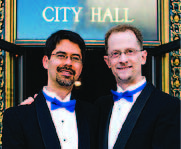 As the day draws near for the Supreme Court to issue its decision in the marriage equality cases, the urge to decipher any clue as to what the Court will decide heightens. Last week, The New York Times reported that as Justice Ruth Bader Ginsburg recently pronounced two gay men married “by the powers vested in her by the Constitution” at a swank D.C. wedding, she did it “[w]ith a sly look and special emphasis on the word ‘Constitution.’” The newspaper also reported that the wedding guests’ wildly enthusiastic response seemed to have “delighted” the Justice. The New York Times’ speculation that Ginsburg’s intonation and reaction may be a “hint” of what the Supreme Court will decide set the news world abuzz.
As the day draws near for the Supreme Court to issue its decision in the marriage equality cases, the urge to decipher any clue as to what the Court will decide heightens. Last week, The New York Times reported that as Justice Ruth Bader Ginsburg recently pronounced two gay men married “by the powers vested in her by the Constitution” at a swank D.C. wedding, she did it “[w]ith a sly look and special emphasis on the word ‘Constitution.’” The newspaper also reported that the wedding guests’ wildly enthusiastic response seemed to have “delighted” the Justice. The New York Times’ speculation that Ginsburg’s intonation and reaction may be a “hint” of what the Supreme Court will decide set the news world abuzz.
The things the Justices said during the Supreme Court’s late April oral argument in the marriage equality cases have also been ripe for speculation. Several of the Justices upon whom we are relying asked questions or made statements that most observers have interpreted as favorable to marriage equality. For instance, Justice Kagan seemed to indicate that she believed the current cases were “exactly what” the Supreme Court’s landmark decision, Loving v. Virginia, which struck down all state bans on interracial couples marrying, was about. In Loving, the Court held that such marriage exclusions violate Americans’ fundamental right to marry and the guarantees of equality that the U.S. Constitution provides. Justice Kagan described how Loving showed that “liberty and…equality are intertwined…”
Justice Breyer also observed that “marriage is about as basic a right as there is” and that the Constitution prohibits a state from “depriv[ing] a person of…basic liberty, without due process of law…” He questioned opponents’ counsel as to same-sex couples’ argument that they have “no possibility to participate in that fundamental liberty” in states without the freedom to marry. Breyer further stated that opponents’ argument that upholding tradition justified states’ same-sex marriage exclusions was “the same way we talk[ed] about racial segregation” during the era of Loving. Justice Sotomayor seemed to agree, apparently rejecting opponents’ argument that LGBT Americans somehow seek a Constitutional right to “gay” marriage and understanding that same-sex couples simply assert their fundamental right to marry that the Constitution guarantees everyone else.
Justice Ginsburg said favorable things as well. She recognized how the evolution of marriage under the law from “a relationship of a dominant male to a subordinate female” to an “egalitarian” institution made it something that same-sex couples would seek to participate in. She also seemed to reject opponents’ argument that same-sex couples’ marrying would somehow harm heterosexuals’ marriages, noting that the freedom to marry for same-sex couples would not “tak[e] away anything from heterosexual couples.” Justice Kagan appeared skeptical of similar arguments from opponents, noting that some people find it “hard to see how permitting same-sex marriage discourages people from being bonded with their biological children.” Justice Breyer asked opponents’ attorney for “empirical” evidence of such a connection, none of which was availing. Soon thereafter, Justice Kagan told opponents’ counsel that he found his reasoning “inexplicable.”
Much attention focuses on Justice Kennedy, who is considered the “swing” vote on the Court in many cases and has written all three of the Court’s landmark LGBT rights cases. Kennedy said relatively little during the argument, but asked questions and made statements that observers have interpreted as favorable to both sides. LGBT supporters were disturbed when early on he gave voice to the argument that a purported “definition” of marriage had been “with us for millennia” and that “it’s very difficult for the court to say, ‘Oh well, we know better.’” Justice Breyer also wanted an answer to questions about the issue.
However, Justice Kennedy also stated that he thought “the whole purpose of marriage” was to bestow dignity on the couple and that same-sex couples seek the same “ennoblement” that other married couples have. In questioning opponents’ counsel, Kennedy recognized same-sex couples’ argument that they seek marriage “in order to show that we, too, have a dignity that can be fulfilled.” Kennedy also noted that approximately the same amount of time has elapsed between the Supreme Court’s landmark LGBT rights decision in Lawrence and the current cases as had elapsed between Brown v. Board of Education and Loving, two of the Court’s landmark race discrimination cases.
Justice Kennedy’s references to the importance of the dignity that marriage confers are heartening. Dignity was central to Justice Kennedy’s opinion in United States v. Windsor, striking down section 3 of DOMA. He emphasized that the State of New York’s decision to end the exclusion of same-sex couples from marriage reflected the state’s decision to “protect” same-sex couples “in personhood and dignity.” Justice Kennedy wrote that “essence” of DOMA was “interference with the equal dignity of same-sex marriages” and that the “injury and indignity” that DOMA inflicted on married same-sex couples was “a deprivation of an essential part of the liberty protected” by the Constitution. He stated that DOMA “tells those couples, and all the world, that their otherwise valid marriages are unworthy of federal recognition,” thereby “plac[ing] same-sex couples
Recent Comments